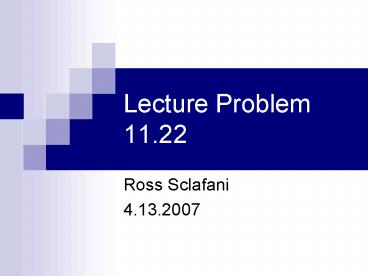Lecture Problem 11'22 - PowerPoint PPT Presentation
1 / 14
Title:
Lecture Problem 11'22
Description:
Gain ductility (less brittle) How? Form martensite (from c) Reheat to tempering temp and expose ... (like Steel hardness and ductility) is critical to your ... – PowerPoint PPT presentation
Number of Views:39
Avg rating:3.0/5.0
Title: Lecture Problem 11'22
1
Lecture Problem 11.22
- Ross Sclafani
- 4.13.2007
2
The Problem
3
The Figure
4
The Background
- Phase Diagram of C iron-carbon alloy
Eutectoid
5
Before We Begin
- How to read an Isothermal Transformation Diagram
- You are only transforming
- the remaining austenite
- You can only move in
- two directions
- Down OR
- Right
6
Example 1
- We start with pure
- austenite
- T 400C
- Microstructures
- _at_t1s 100 austenite
- _at_t20s 50 austenite
- 50 bainite
- _at_t103s 100 bainite
7
Example 2 Time Travel?
- Diagram only shows transformations over time at a
fixed temp. - We always start from the far left (t0s)
- However, we can also cool to a 2nd temperature
- T1400C, T225C
50 Bainite
50 Bainite 50 Martensite
8
The Solution
- What exactly is proeutectoid cementite?
- Cementite (Fe3C)
- Lever Rule
- If we pass through this
- temp range Cem. will form
9
The Solution
- Back to the isothermal transformation
- Cool (instantaneously) from 900C to 680C
- (forming 6.2 p.c.)
- Expose at 650C for 10s
- remaining 93.8 austenite ? pearlite)
10
The Solution
- Pearlite transformations
- Coarse High T, High carbon diffusion rate,
thick stripes - Fine Low T (600C), Low diffusion, thin stripes
- Only expose to dashed line (50 line)
- Cool to bainite temp and cure
- Technically, impossible for 50/50 due to
cementite formation (6.2C, 46.9P, 46.9B)
11
The Solution
- Martensite ? very hard
- However, very brittle
- Formed simply by quenching (or cont. cool to room
temp) austenite
Optional
12
The Solution Last One!
We want our tempering time to be reasonable (not
105s 1 day) Pick 425C for this application to
achieve significant gains
- Benefits of tempering
- Sacrifice hardness
- Gain ductility (less brittle)
- How?
- Form martensite (from c)
- Reheat to tempering temp and expose
- Gains dependent on temper temp AND time
13
Why Should You Care?
- When controlling materials properties (like Steel
hardness and ductility) is critical to your
application - One example everyone is familiar with
- E8 Both your hammer head and screwdriver blade
were heated, quenched (to form martensite), then
tempered to a specified hardness - Now your hammer wont shatter when you hit a nail
14
Any Questions?































